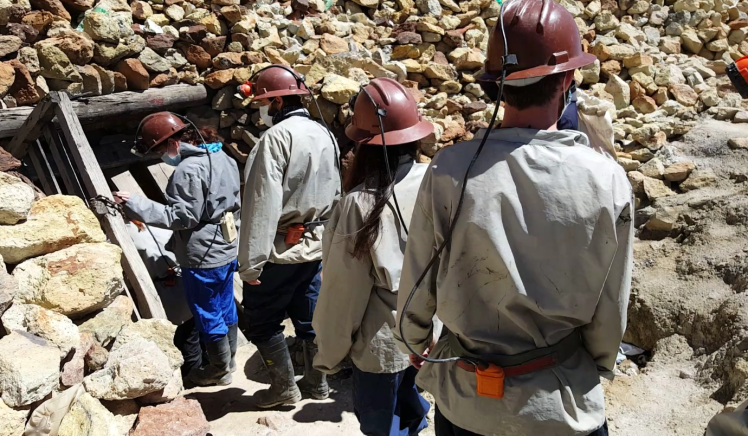Bolivia – La Paz • Sucre • Potosi • Uyuni Salt Flat • Chile – San Pedro de Atacama • Salta and Argentina – Buenos Aires • Brazil – Rio de Janeiro •
Potosí is famed for its mountain Cerro Rico. It is known as the ‘mountain that eats men’ because a lot of workers died in the mines.
The travel time is four to five hours to Potosí from Sucre, it goes back up to high altitude via winding road and is 4,060 meters above sea level. The Spanish became rich when they invaded South America in the 16th century, it gave them more than enough silver to build a bridge from Potosí to Madrid. More than 10,000 people worked in the mines and mined 60,000 tons of silver. Silver is now long gone but the mining still goes on for the economy and helps with tourism, former miners now run tours! Potosí was one of the biggest and wealthiest cities in the world, but now it is the poorest city in Bolivia.

The Devil’s Mine – Before the group decided to join a scheduled mine tour, we watched a touching documentary to learn about mines.
It is about a fourteen-year-old boy’s story as a Potosí miner called Basilio. His brother Bernardino was also in the film when he was 11 years old. Their father, who was not a miner, died young. Basilio becomes the breadwinner of the family. We were awe-struck throughout the entire movie; anyone who complains about their first-world problems should watch it. Mining has gone on for over 500 years, and most people that have worked
The film was made in 2005, after which a lot of NGOs (non-governmental organizations) came to help children to keep them in school. Work conditions have improved a bit but are still dangerous and miners are still underpaid. Tourism increases help and other organizations contribute and offer support.

This comment caught my eye. “Simply filming it looked harrowing. Kief Davidson (one of the directors) mentioned that in one scene, where they are examining the Devil in a particular mine, one of the boys looks round suddenly a moment or two before the scene cuts. The reason not shown in the film was that there had been an explosion (unexploded dynamite is a constant hazard) and the miners wanted to get out before the tunnel collapsed and killed them all. But what worried them more was the fact that the film crew attempted to take some of the trappings from the Devil’s altar.”
Tour – When I wanted to sign up for a tour to see how miners work, I was worried about being exposed to chemicals, and gases and thought what if the mind can collapse at any time? When I asked Gabi ‘where are these boys from the documentary now?’ imagine my excitement when she said Bernardino (Basilio’s little brother) was going to be my guide! He is around 20 years old now and he has been working as a guide along with his older brother. Sadly we didn’t see Basilio as he was busy with his tourism studies.
Other tourists might not have had the opportunity to see the documentary but I was happy to get this by signing up with the G-Adventure agency. My friend and I were amazed by how Bernardino walked into the cave, the dangers didn’t faze him. It was an honor to meet him after watching him as a child in the film. He spoke a bit of English and he found it easy to gesture to us as he saw that we were using British Sign Language (BSL). He understood that we felt left out a bit as he kindly took us to the processing plant and gestured while the other guide talked to the group.





The guide said miners usually die of silicosis (a lung disease) after ten to twenty years of working in the mines. There are no other job opportunities in Potosí, they know the dangers they have to endure to provide for their families. He also told us about El Tio or ‘the uncle’ a devil-like spirit in the shape of a statue.
History – The locals were forced to work 24-hour shifts in the mines and if they did get to sleep they only had four hours, so they kept awake with coca leaves (the source of cocaine). When the native Bolivians tried to rebel they introduced the fear of the devil god statues to keep them in line. Lots of children were made orphans and had to work at a really young age, and from 12 to 14 they became the heads of their households. The laws against child labor are ignored – the children are earning only $2 a day (£1.37).




We were given overalls to put on, wellington boots, equipment such as a helmet with a lamp and mask even though you still could be exposed. The tour began with a visit to the miner’s market where they stocked up on dynamite, cigarettes, and other essentials. Gabi explained: “In the past, gifts weren’t expected, but with the growing number of tourists, you’d be very unpopular if you didn’t supply a handful of coca leaves and a few cigarettes, luxuries for which the miners’ meager earnings are scarcely sufficient”. After the miners market, we went to a processing plant to see how they process the materials they extract from the mines.

Shop at Potosí Miners’ Market
We missed out on the explanations from the guide because there was no sign language interpretation, but one girl called Jasmin from the group was very kind to text us what was being said on her mobile. Gabi, the team leader emailed us about this before the next day so we decided to go with the idea. That tour company my agency organized was run by ex-miners and all the profits we paid for the tour went directly to the guides themselves. I was told that the dangers of going into mines and seeing people’s suffering might make me feel stunned or ill afterward.
My friend hesitated but joined at the last minute, but then I was all up for it and ended up sitting it out at the last minute when I approached that hole pitch entrance. It’s not a good idea if you are claustrophobic, my friend was so brave to go ahead and spend a couple of hours crawling through narrow muddy passageways.
I would recommend you to visit just to experience what the miners are having to live with. A deaf man I met working in the supermarket had said he worked in the mountain for a few years but eventually, he managed to get out. He also said it is not easy for deaf people here with no deaf awareness. About 23 deaf people are working in mountains.
Casa Nacional de la Moneda (‘National House of the Mint’) is now a huge museum, dating back to 1572. It is where the silver from Cerro Ricco was minted into coins. A strange statue of a grinning face hangs over the courtyard in the museum, which I read is kind of suitable to show the greed of the Spanish colonisers.




I hope you enjoy reading it as much as I enjoyed writing it.
















